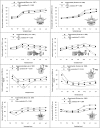Prediction equations for human thoracic and lumbar vertebral morphometry
- PMID: 20039978
- PMCID: PMC2829390
- DOI: 10.1111/j.1469-7580.2009.01187.x
Prediction equations for human thoracic and lumbar vertebral morphometry
Abstract
Statistical correlations between anatomical dimensions of human vertebral structures have indicated a potential for the prediction of vertebral morphometry, which could be applied to the creation of simplified geometrical models of the spine excluding the need for preliminary processing of medical images. The aim of this study was to perform linear and nonlinear regressions with published anatomical data to generate prediction equations for 20 vertebral parameters of the human thoracic and lumbar spine as a function of only one given parameter that was measured by X-ray. Each parameter was considered individually as a potential predictor variable in terms of its correlation with all of the other parameters, together with the readiness with which lateral X-rays could be obtained. Based on this, the parameter vertebral body height posterior was chosen and the statistical analyses described here are related to this parameter. Our linear, exponential and logarithmic regressions provided significant predictions of anterior vertebral structures. However, third-order polynomial prediction equations allowed an improvement on these predictions (P-values < 0.001), e.g. endplates and spinal canal (R(2), 0.970-0.995) as well as pedicle heights and the spinous process (R(2), 0.811-0.882), in addition to a reasonable prediction of the posterior vertebral structures, which have shown a low or no correlation in previous studies, e.g. pedicle inclination and transverse process (R(2), 0.514-0.693) (anova). Comparisons of the theoretical predictions with two other sets of experimental data indicated that the predictions generally agree well with the experimental data. A time-efficient approach for obtaining anatomical data for the description of human thoracic and lumbar geometry was provided by this method, which requires the measurement of only one parameter per vertebra (vertebral body height posterior) from a lateral X-ray and the set of developed prediction equations. Vertebral models based on this type of parameterized geometry could be used in biomechanical studies that require geometry variation, such as in spinal deformations, including scoliosis.
Figures







Similar articles
-
Morphometric analysis of the relationships between intervertebral disc and vertebral body heights: an anatomical and radiographic study of the human thoracic spine.J Anat. 2011 Sep;219(3):375-87. doi: 10.1111/j.1469-7580.2011.01397.x. Epub 2011 May 25. J Anat. 2011. PMID: 21615399 Free PMC article.
-
Prediction of the human thoracic and lumbar articular facet joint morphometry from radiographic images.J Anat. 2011 Feb;218(2):191-201. doi: 10.1111/j.1469-7580.2010.01323.x. Epub 2010 Nov 29. J Anat. 2011. PMID: 21114666 Free PMC article.
-
Geometrical dimensions of the lower lumbar vertebrae--analysis of data from digitised CT images.Eur Spine J. 2000 Jun;9(3):242-8. doi: 10.1007/s005860000140. Eur Spine J. 2000. PMID: 10905444 Free PMC article.
-
Aging changes in vertebral morphometry.Calcif Tissue Int. 1995 Dec;57(6):426-9. doi: 10.1007/BF00301945. Calcif Tissue Int. 1995. PMID: 8581874
-
The position of the aorta relative to the spine: a comparison of patients with and without idiopathic scoliosis.J Bone Joint Surg Am. 2003 Aug;85(8):1461-9. J Bone Joint Surg Am. 2003. PMID: 12925625
Cited by
-
Percutaneous Pedicle Screw Placement Aided by a New Drill Guide Template Combined with Fluoroscopy: An Accuracy Study.Orthop Surg. 2020 Apr;12(2):471-479. doi: 10.1111/os.12642. Epub 2020 Mar 4. Orthop Surg. 2020. PMID: 32133781 Free PMC article.
-
Sagittal Plane Geometry of Cervical, Thoracic, and Lumbar Endplates.Int J Spine Surg. 2022 Aug;16(5):792-799. doi: 10.14444/8336. Epub 2022 Aug 31. Int J Spine Surg. 2022. PMID: 36302610 Free PMC article.
-
[Anatomical and radiological aspects in lumbopelvic fixation].Unfallchirurg. 2013 Nov;116(11):979-84. doi: 10.1007/s00113-012-2336-3. Unfallchirurg. 2013. PMID: 24233082 German.
-
Morphometric analysis of the relationships between intervertebral disc and vertebral body heights: an anatomical and radiographic study of the human thoracic spine.J Anat. 2011 Sep;219(3):375-87. doi: 10.1111/j.1469-7580.2011.01397.x. Epub 2011 May 25. J Anat. 2011. PMID: 21615399 Free PMC article.
-
Lumbar model generator: a tool for the automated generation of a parametric scalable model of the lumbar spine.J R Soc Interface. 2018 Jan;15(138):20170829. doi: 10.1098/rsif.2017.0829. J R Soc Interface. 2018. PMID: 29298959 Free PMC article.
References
-
- Aharinejad S, Bertagnoli R, Wicke K, et al. Morphometric analysis of vertebrae and intervertebral discs as a basis of disc replacement. Am J Anat. 1990;189:69–76. - PubMed
-
- Aubin C-É, Dansereau J, Parent F, et al. Morphometric evaluation of personalised 3D reconstructions and geometrical models of the human spine. Med Biol Eng Comput. 1997;35:611–618. - PubMed
-
- Bernick S, Cailliet R. Vertebral endplate changes with aging of human vertebrae. Spine. 1982;7:92–97. - PubMed
-
- Berry JL, Moran JM, Berg WS, et al. A morphometric study of human lumbar and selected thoracic vertebrae. Spine. 1987;12:362–367. - PubMed
-
- Breglia DP. Generation of a 3-D Parametric Solid Model of the Human Spine Using Anthropomorphic Parameters. Ohio: Ohio University; 2006. Master dissertation.
Publication types
MeSH terms
LinkOut - more resources
Full Text Sources

